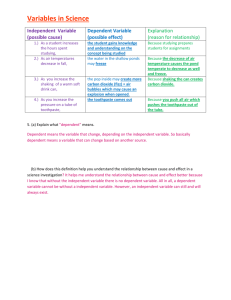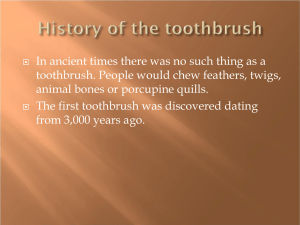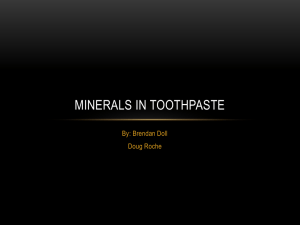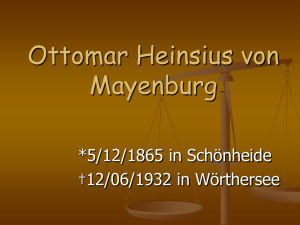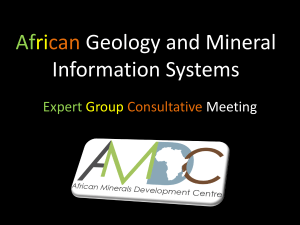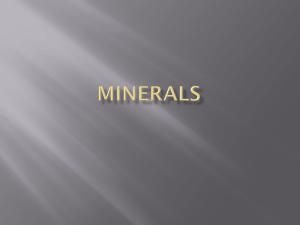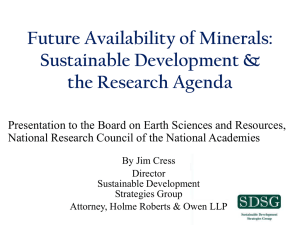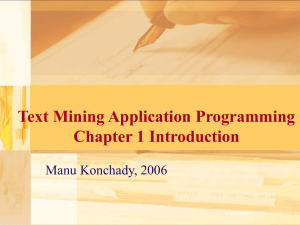Presentation - Minerals Education Coalition
advertisement
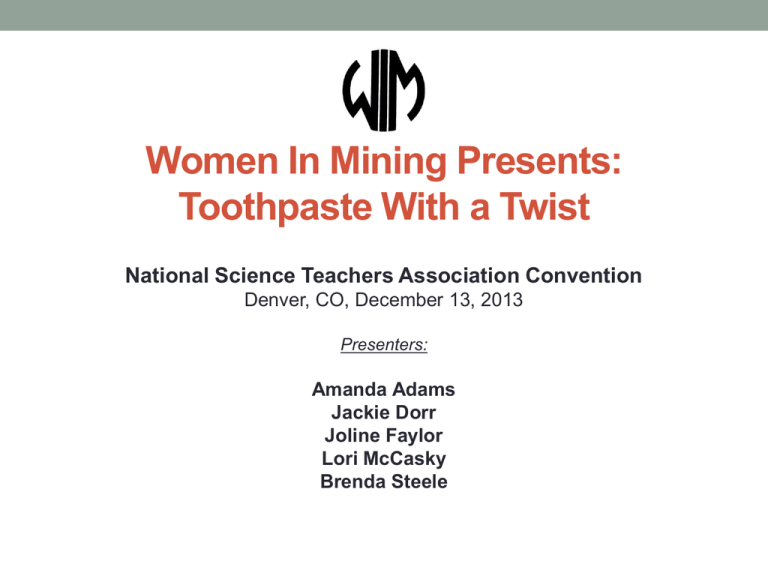
Women In Mining Presents: Toothpaste With a Twist National Science Teachers Association Convention Denver, CO, December 13, 2013 Presenters: Amanda Adams Jackie Dorr Joline Faylor Lori McCasky Brenda Steele womeninmining.org Free K-12 Classroom Activities * Listed Alphabetically * Listed By Standard Mining Schools Outreach Workshops Careers in Mining Other Resources mineralseducationcoalition.org Free K-12 Activities Listed by Grade Level Low Cost Supplemental Products, Posters, CDs Minerals Database and Photos Reclamation Success Stories Annual Mineral Consumption Data Careers in Mining If the Question is: Why do we mine? The Answer is … Every Year — 38,212 pounds of new minerals must be provided for every person in the United States to make the things we use every day! Products people use daily are manufactured directly from minerals, or use components that were made from minerals. In this activity we look at one product we use every day – toothpaste. Calcium Carbonate A white or colorless crystalline compound occurring naturally in chalk, limestone, and marble and in the minerals calcite and aragonite. It is used to make toothpaste, white paint and cleaning powders. Sodium Bicarbonate Also called baking soda. A white crystalline soluble compound used in effervescent drinks, baking powders, fire extinguishers, as a disinfectant, and in medicine as an antacid. Materials Needed Calcium carbonate (CaCO3), food grade Sodium bicarbonate (NaHCO3) (baking soda) Water Small plastic cups Plastic spoons Sticks for stirring Assorted food colors and flavorings Eye droppers Optional items: • Hydrogen peroxide, (H2O2) (3%) • Fluoride • Sweetener (not sugar) • Diatomite, food grade Have some commercial toothpaste samples available. Procedure 1) Basic recipe for toothpaste is: a) 1/2 teaspoon calcium carbonate. b) 1/4 teaspoon sodium bicarbonate. c) Mix together in a small plastic cup. d) Add just enough water (with eye dropper) to make a paste. 2) Have the students taste the basic recipe and discuss possible improvements. a) Divide the class into groups of 4 and let them come up with some solutions to make the basic recipe more appealing to others. i) Remember, the purpose is to produce the most “marketable” toothpaste. b) Each group is responsible for one recipe. i) As the samples are quite small, only small amounts of color and flavoring are needed. c) Each group will keep a record of their recipe and submit it with the sample for judging. i) The judges (another class, parents, etc.) will determine the winner. ii) Have a prize for the winning sample. Worksheet Group No. Product Name ___________________ Basic Recipe: 1/2 tsp. calcium carbonate, 1/4 tsp. sodium bicarbonate, water to form paste. ADDED: Ingredient(s): Flavoring(s): Color(s): ______________________________________________ ______________________________________________ ______________________________________________ AD CAMPAIGN: Slogan (if any) ______________________________________________ 15 second advertisement: ____________________________________________________________ ____________________________________________________________ ____________________________________________________________ ____________________________________________________________ ____________________________________________________________ Correlation to National Science Education Standards Standard Concept General standard Grade Level Science as Inquiry (A) Specific standard K-4 Abilities … to do … inquiry Earth and Space Science (D) Properties of Earth materials Science and Technology (E) Abilities of technological design Specific standard General standard Specific standard 5-8 9-12 E.1.8.1 E.1.12.1 E.1.4.2 E.1.8.2 E.1.12.2 E.1.4.3 E.1.8.3 E.1.12.3 E.1.4.4 E.1.8.4 E.1.12.4 E.1.4.5 E.1.8.5 A.1.4.1 D.1.4.1 E.1.4.1 Understanding about science and technology E.2.4.2 Distinguish between natural and humanmade objects E.3.4.1 E.3.4.2 Science in Personal and Social Perspectives (F) General standard Personal health F.1.4.2 Types of resources F.3.4.1 Abilities of technological design E.1.12.5 Understanding about science and technology E.2.12.3 Evaluation 1) How did the homemade toothpaste compare to commercial products? 2) What mineral is added to toothpaste to fight cavities? 3) How many of the commercial toothpastes had minerals in them? 4) Have the students compare the prices of commercial toothpaste in relation to the number of mineral ingredients. a) Which were more expensive? 5) Have the class develop an advertising campaign for the winning toothpaste. a) This can be a slogan, jingle, drawing, rap or a song that will help sell their toothpaste. b) Have a prize for the winning ad campaign. Resources Calcium Carbonate from Amazon: • http://www.amazon.com/ Women In Mining (WIM): http://www.womeninmining.org/default.asp • Classroom Activities Listed Alphabetically • Classroom Activities Listed By Standard • Mining Schools • Outreach Workshops • Other Resources Minerals Education Coalition (MEC): http://www.mineralseducationcoalition.org/ • K-12 Activities • Mineral Photos and Database • Careers in Mining • Reclamation Success Stories • Plate Tectonics Activity Society for Mining, Metallurgy & Exploration Inc. (SME): http://www.smenet.org/ • Visit The Convention Center Booth #432: Minerals Are Life Other Resources American Coal Foundation: http://teachcoal.org/ American Coalition for Clean Coal Electricity: http://www.cleancoalusa.org/ American Geological Institute: http://www.agiweb.org/ ASARCO Mineral Discovery Center: http://www.agiweb.org/ The Copper Development Page: http://www.copper.org/ Energy Information Administration: http://www.eia.gov/ Florida Institute of Phosphate Research: http://www.fipr.state.fl.us/ Frank Potter's Science GEMS: http://www.sciencegems.com/ Geological Society of America: http://www.geosociety.org/ NASA Wavelength: http://nasawavelength.org/ National Earth Science Teachers Association: http://www.nestanet.org/ National Energy Foundation: http://nef1.org/ National Mining Association: http://www.nma.org/ National Science Teachers Association: http://www.nsta.org/ Smithsonian Museum-Nat’l History; Mineral Sci: http://mineralsciences.si.edu/ Steve Spangler Science Experiments: http://www.stevespanglerscience.com/ The Silver Institute: https://www.silverinstitute.org/site/ The Gold Institute: http://goldinstitute.net/ United States Geological Survey: http://education.usgs.gov/ Be Sure To Visit Convention Center Booth #432: Minerals Are Life
